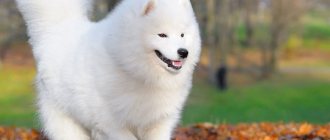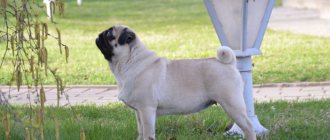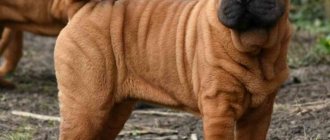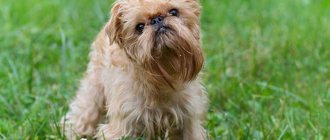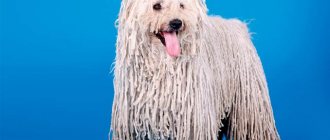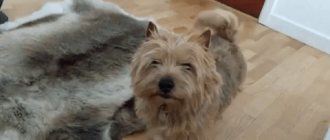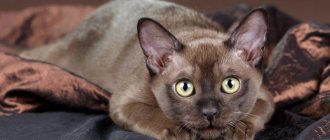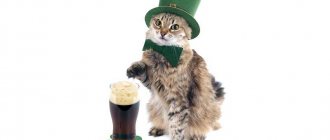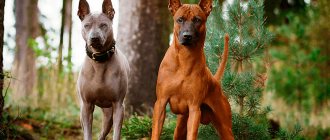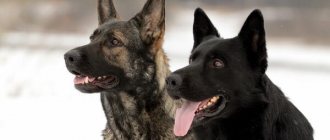In our country, decorative pug dogs have become very popular. These animals become strongly attached to their owner and all family members. They have an original and funny exterior, an affectionate character and an amazing disposition. The pug breed is shrouded in many legends and myths, and their depiction in sculptural compositions and in films receives increased attention from amateur livestock breeders.
Breed characteristics
| Short description | |
| Origin: | China |
| Conditions of detention: | Apartment, house |
| Purpose: | Companion dog |
| Color: | Yellowish, silver or chocolate black |
| Wool length: | Short |
| Adult dog size: | Height 28-32 cm, weight approximately 6.3-8.1 kg |
| Average life expectancy: | 13-15 years old |
| Walk: | Need two short walks a day |
| Physical activity needs: | Low physical activity needs (walk 1-1.5 hours per day) |
| Fédération Cynologique Internationale (FIC) classification: | Group 9: decorative and companion dogs; Section 11: Lesser Molossoids |
| Puppy price: | From 10,000 to 30,000 rubles. Without pedigree - 10,000-12,000 rubles, pet class - 15,000, breed class - 20,000-25,000, show class - 30,000 and above |
Pugs breeding
Breeding pugs is a rather complex process that requires experience and knowledge. The owner of such a dog, who decides to start breeding it, must thoroughly know not only physiology, some basic veterinary medicine, and also study the basic rules for selecting sires.
The main importance for obtaining healthy purebred offspring is the correct choice of sires. In this case, the physical form of the pug, its physique, characteristics of the breed, and character must be taken into account.
Puberty in female pugs occurs at approximately 8 months, and in males - in a year and a half. However, puberty is not the main thing. The general physical maturity of the entire canine body is also important here. That is, breeding pugs should not be too young or too old. The optimal reproductive age of this dog breed is: for females - from 1.5 to 6 years, for males - from 2 to 7 years. Female pugs do not have sexual cycles (estrus) very often.
Only twice a year and they are divided into three phases:
- Proestrum;
- Estrus;
- Metoestrum.
Mating of pugs is carried out in the male’s house and is recommended from the 9th to the 12th day of the cycle. Re-mating is carried out after a couple of days. The act of mating in dogs lasts about an hour (40-60 minutes), and it is strictly not recommended to separate the animals until the end of mating.
In order to avoid exhaustion of the female’s body and the appearance of inferior offspring, experienced dog breeders do not recommend breeding her more than once a year. At the same time, males are used for mating much more often.
Pregnancy of pugs, like most dogs, is usually multiple (4-6 puppies), its duration is approximately 60-62 days. The first signs of pregnancy appear in the second month.
These include:
- Increased appetite;
- Increase in body weight;
- Increased abdominal volume;
- Behavior change.
In order to determine the exact number of offspring, the bitch's belly is very carefully and carefully palpated. During pregnancy, the female pug is transferred to an enhanced, balanced diet, giving her more meat, dairy products, and special vitamin supplements. Regular daily walking for at least two hours is also recommended throughout pregnancy. This is necessary to strengthen muscles, improve metabolism and supply the body of both the dog and future puppies with oxygen.
Proper nutrition and proper care during pregnancy, as a rule, ensure that the course of labor in a pug goes without complications. During the first time after birth (1.5-2 months), the dog is protected from physical exertion, reducing the duration of walks.
For the female and newborn puppies, you should allocate a large box and keep it clean, regularly changing the bedding.
History of the origin of the species
Ancient China is considered the birthplace of Pugs. It was there that short-faced, square dogs similar to Pekingese were held in high esteem. By the way, they are identified as the ancestors of Pugs, but this has not been proven genetically. At that time, there were 2 similar breeds: Ha Pa and Lo Jie. The first were long-haired, while the second were most similar to modern Pugs.
Luo Jie could be kept by any person who had sufficient material income to support it, because such a dog was carried on special chairs by hired people, preventing the pet from becoming overloaded. Ha Pa were considered exclusively imperial pets, which were forbidden to be taken out of the palace.
There is an assumption that Luo Jie were bred by Buddhist monks. Such dogs were considered sacred and good luck. People believed that the folds on their foreheads formed special hieroglyphs.
Pug itself is considered Dutch. At first, this breed was called by different names. For example, the French called the dogs Carlins, in honor of the famous actor Carlino, whose stage mask looked like the face of a Pug. The English name " Pug " translates as " pug ". Throughout Europe, these dogs were known as boudoir dogs, they kept their owners warm in unheated spaces.
Pugs came to the European part of the continent thanks to active trade between China and France. This happened around 1550. The breed quickly gained popularity and spread to other countries. She was held in special esteem in Holland. The peach color of the dogs was likened to the state colors of the ruling Orange.
In addition, one of the favorites of Queen Mary II of Orange saved the king’s life during the war with Spain (16th century). The dog woke him up with his barking, warning him of the enemy's attack.
For a long time the breed was at the peak of popularity in France. Especially during the reign of Napoleon. The fact is that the Pug named Fortuna was the favorite of the bride of Emperor Josephine. But, after the return of Bourbon power, these dogs were no longer bred in pursuit of political goals. Indiscriminate selection and improper maintenance have worsened the gene pool of the breed. Pugs were on the verge of extinction.
In 1864, Queen Victoria demanded that a purebred dog be found. An individual was found, but at least one more was required for selection. She was brought from China, like many others. During this period, the breed branch was divided according to the colors of the dogs: the first was called “warmth of the sun” (beige and peach dogs), and the second “black of the night” (black and chocolate).
The first breed club was officially registered in 1883. Since that time, orderly and consolidated work has been carried out on the development of dogs. The standard was published in 1888.
The photo shows a black pug
Origin information
Similar Chinese dogs "Lo Dze" belonged to noble gentlemen and lived in the imperial palace, as well as in many noble houses.
Many engravings and figurines of the 17th - 18th centuries depict such dogs with beautiful collars decorated with bells.
In those days, dogs of this breed did not have such deep wrinkles and folds, but a clearly defined folded pattern on the forehead was already present.
It was the hieroglyphic image of the frontal part that made this breed sacred and revered. The Chinese saw in the drawing secret signs that were supposedly drawn by God himself. Therefore, the frontal hieroglyphs were called royal marks.
Distinctive features
Pugs are proportional, strongly built, square dogs. The closer the height at the withers is to the length of the body, the higher the individual is rated. Overall the breed is small. Both females and males are no larger than 32 cm . Their weight ranges from 6 to 8 kg.
Due to improper selection in the Middle Ages, Pugs acquired many congenital defects, so it is difficult to find the ideal dog. So, at the moment, individuals are distinguished that resemble terriers (refined and graceful) and bulldogs (larger, heavier and more muscular). None of the types is considered standard, but some dogs even take prizes at shows.
Judges place many demands on the shape of the Pugs' head. It should form a clear square without lengthening, narrowing or bulging. Although initially the correct skull should have looked like a monkey.
- The head is square, round, massive, but proportional to the body. No skull bones should be visible.
- The muzzle is abundantly covered with wrinkles (their size is also mentioned in the standard; the fold between the skull and muzzle should not be too large or small), square, short, but not upturned. The nose line is straight. The lower jaw is wide, the bite is of the “overshot” type (but insignificant).
- The nose is small, upturned, flat. Black color.
- The eyes are large, but not protruding. Set quite wide, almost in line with the nose. Dark and shiny.
- Ears can be either “button” or “rose”. Both types are allowed by the standard. Excessively long ears, low-set and half-raised ears are not allowed.
- The body is short, muscular, strong, and square in shape. Fat Pugs are disqualified. The body should be surrounded by wrinkles, but not Shar Pei-shaped. The top line is straight, the bottom line is tucked. The chest is quite wide with rounded ribs. The neck is of medium length, slightly arched, without dewlap but with skin folds.
- The tail is short, tightly curled into two rings and pressed to the lower back (one ring is acceptable).
- Limbs straight, parallel, strong. Excessively short or long limbs are considered a defect. The paws are not long (like those of a hare), but not round (like those of a cat). Well developed fingers. The movements are rolling, but not hobbling.
- Skin and folds. The skin is dense and elastic. The folds are symmetrical throughout the body. Of particular importance are the folds on the muzzle, frontal part and around the eyes, as well as around the head and neck. An additional advantage will be the folds on the wrists.
- The coat is harsh, short, and not fluffy. There is a slight extension on the tail.
- Colors: silver, peach, beige and black. Light colored pugs should have a black mask, darkening on the ears, paws, crest and forehead. Moles on the cheeks are characteristic.
Health and major diseases
Due to the structure of the body and muzzle, pugs are predisposed to diseases as :
- Perthes disease, or aseptic necrosis of the femoral head. This is a genetic disease that interferes with blood circulation in the hip joint, leading to muscle atrophy and lameness. Diagnosed in dogs aged 4-10 months, it can only be cured by removing the femoral head.
- Juvenile demodicosis. Also a genetic disease, with a high degree of probability transmitted to the puppy from the mother. If pathology is detected at an early stage of development, the dog can be cured quite quickly through comprehensive treatment.
- Eye injuries, most often – loss of the eyeball. In such a situation, the pet requires immediate assistance from a veterinarian.
- Glaucoma. With this disease, intraocular pressure increases, which, in the absence of the necessary treatment, leads to blindness.
Also dangerous for these small dogs are:
- plague;
- keratitis;
- otitis;
- dermodicosis;
- allergy;
- obesity;
- rabies.
IMPORTANT!
Pugs need regular vaccination, taking place in 3 stages before the pet reaches one year of age, and then once a year for prevention and maintenance of immunity.
It should be remembered that diseases affect the life expectancy of a pug. Therefore, the issue of dog health must be taken seriously.
Photo of an adult dog
Education and training
The very first thing you should teach your pet is its name.
Pugs are smart and quick-witted, but stubborn and may simply not want to follow commands, so when training the dog, the owner must show patience and leadership qualities.
It is necessary to start classes as early as possible, starting with a set of basic commands like “sit” and “no”.
You should also accustom your pet to a bed (the “place” command), otherwise the dog will sleep in the owner’s bed.
To train, you need to develop a system and carry it out regularly twice a day. The owner must behave persistently, but patiently and gently, not show aggression and not physically punish the pet.
For all achievements and completed commands, the pug must be encouraged and praised . This way he will have the incentive and desire to continue learning.
In addition to learning commands, the pug needs to be accustomed to a harness, leash and muzzle.
Photos of puppies
Brief comparison with other similar breeds
Pugs also have some similarities with Pekingese, mainly regarding character, origin and behavior.:
- both breeds originate from China;
- both have a shortened muzzle;
- cannot tolerate long separation from the owner;
- equally capable of training;
- prone to similar diseases related to the respiratory system and eye problems.
But most often, despite the rather extravagant appearance of pugs, they are often confused with French bulldogs.
Both breeds have a compact size and a square body format, however, bulldogs have erect, rounded ears, a curved tail and powerful jaws.
Bulldogs are also more active and playful.
Read more about which dog breeds are similar to the pug here.
Features of character and behavior
- Opinions about the character of Pugs vary greatly. Some people notice irresistible laziness and phlegmatic behavior in their pets, while others notice cheerfulness, activity and a positive mood. In fact, each Pug is unique. They can be true aristocrats or fidgets; it is almost impossible to understand how the puppy will grow up.
- All representatives of the breed are characterized by a complete absence of aggression, hunting and protective instincts. This dog was bred only as a companion. Pugs are loyal and loving, they actually follow their owner’s tail and strive to participate in all areas of his life.
Advantages
- These dogs are friendly, non-aggressive and sweet. Many people get such pets just because of their friendly, funny faces.
- Pugs are sociable and loving, they like to be near their owner and give him all the tenderness.
- They are neutral towards children and tolerant towards strangers, but may exhibit protective instincts and bark.
- Quite energetic, but despite this, they like to lie for a long time and watch TV.
- Another plus of the breed is that Pugs do not need long walks, or rather, they are contraindicated. These dogs are perfect for sedentary and elderly people.
- There is an opinion that a pet's temperament depends entirely on its color. It is believed that black Pugs are more active, which cannot be said about light Pugs, who like to spend time lying down.
We can say that this is one of the most intelligent decorative breeds. Pugs are easy to train, although the owner will have to deal with their stubbornness.
Flaws
- The main character flaw of Pugs is stubbornness. Yes, these are little lambs in a dog's skin. If they don’t like something, they may even be offended. Because of this, training becomes quite difficult and the educational process takes a long time. It is not easy to accustom such a dog to a daily routine and toilet.
- Such pets are really very trusting and kind. Dog thefts often occur on the street.
- Quite jealous. They do not like it when the owner pays attention to anyone else. In addition, Pugs cannot stand long-term loneliness and literally follow the heels of their household members.
- Caring for such a dog is intensive and difficult. Many people are frightened by this particular feature. The problem becomes skin folds and eyeballs. Pugs also often snore and sniffle. They can be mischievous and like to chew shoes and furniture.
Video
* We invite you to watch a video about the Pug . In fact, in front of you is a playlist in which you can select and watch any of 20 videos about a given dog breed by simply clicking on the button in the upper right corner of the window. In addition, the material contains quite a lot of photos. By looking at them you can find out what a Pug looks like.
In this article:
|
Care and maintenance
At first glance, Pugs do not seem to be problematic pets: their hair is short and their size is small. But if you learn about the problems of the breed itself, it becomes clear that there are certain nuances in care.
- Firstly, these dogs have quite large eyes, which is why frequent injuries and diseases occur.
- Secondly, there are a huge number of folds that need to be inspected and wiped.
- Thirdly, a huge number of congenital and acquired defects.
This dog is absolutely not suitable for being kept outside. It is intended for home use. In the first months of your Pug's life, you need to provide him with a room with carpeted floors. This is necessary for the formation of the correct gait.
Although such pets usually sleep with their owner, they still need “their own corner” where they can rest. It is important that this place is not exposed to drafts and is not exposed to open sunlight. In addition to a comfortable bed, you need to purchase toys (Pugs love to chew), hygiene products and bowls with legs (with adjustable height).
Nutrition
Pugs are allergic; in addition, they are prone to obesity due to a sedentary lifestyle. Therefore, their diet should include low-calorie foods designed for small breeds. A good option would be holistic dry food (grain-free), hypoallergenic super-premium class. They are easy to use, but quite expensive. You should also read the ingredients of products to avoid negative consequences.
When feeding naturally, the owner will have to be very careful . Pugs are picky and will not eat everything, although they love to beg. Also, their body may reject a particular product due to indigestion. If the breeder advises feeding with what they fed in the nursery, then it is better to do so.
In any case, natural nutrition is possible. It is worth remembering that a dog is a carnivore, so meat should be the basis of the diet. It can be lean beef, rabbit, or lamb. The second most important elements are cereals. Cereals cooked in broth or water. You can feed your pet vegetables and fruits, boiled sea fish without bones and eggs.
Products that should NOT be on the menu:
- Fat cottage cheese, kefir, sour cream;
- Pork;
- Liver (coat color deteriorates);
- Bones;
- Flour (especially white bread);
- Sweet;
- Garlic and onion;
- Citrus;
- Grape.
This list is approximate. Each pet is individual, so you need to monitor its reaction to each new product.
Adult Pugs need 2 meals a day. Puppies are fed 3-5 times a day. It is not recommended to disrupt the feeding regime with treats.
Health
The health of these dogs is a controversial topic. Some believe that Pugs are actually predisposed to many inherited genetic diseases. Others are sure that all problems come from improper care. One way or another, the average life expectancy of these cute creatures is 12-15 years.
Vaccinations
Vaccination of a pet is the key to strong immunity and resistance to dangerous viruses. Many owners are sure that if the dog does not walk and does not get to know other animals, then it does not need vaccinations. In fact, millions of biological components, including viruses, are carried on people during their constant migration between home and street. Therefore, there is always a risk of contracting an infection.
Thus, the puppy needs a primary double vaccination, most often done at 2 months , when the maternal immunity stops working.
- The first vaccination is usually carried out by breeders: this is a complex drug against many infectious diseases.
- The owner must follow the calendar of procedures and repeat the vaccination after 2 weeks , at 6 and 12 months . After this, the vaccine is updated annually.
- Another drug necessary for strong immunity against rabies. It is introduced when the baby turns 7 months . This vaccination also needs to be renewed annually.
The cost of the drug depends on the size of the dog and the status of the veterinary clinic. Usually the price ranges between 500-1000 rubles.
Worth remembering:
- Before vaccination (2 weeks before), the pet must be dewormed.
- Vaccination is not given to sick or malnourished dogs, pregnant bitches and male dogs after mating.
- All procedures must be carried out under the supervision of a veterinarian.
- In case of prolonged negative symptoms, you should contact a clinic.
Diseases
Diseases to which representatives of the Pug breed are predisposed:
- Corneal erosion (a severe hereditary eye disease that can be treated with antibiotics);
- Breathing problems, shortness of breath (often associated with an abnormally shaped bridge of the nose);
- Infections, inflammations and dermatitis of skin folds;
- Early tooth loss and gum inflammation;
- Food allergies;
- Obesity.
Walk
Pugs cannot be called overly active, but they are not too lazy either . Yes, they don’t mind lying on the couch all day, but this doesn’t mean that such dogs don’t need a walk. These dogs can be house trained, as their bladder is quite weak, but twice daily walks are a must. Each session lasts no more than 40 minutes.
In hot weather, intense exercise and sun rays should be avoided; swimming in city waters would be a good way to walk. In winter, Pugs can catch a cold, so they are dressed in protective overalls. Walking through snowdrifts strengthens the muscles of the limbs and back.
Puppies can be walked after the second vaccination. At first, they are carried out in your arms for 15-20 minutes 3-4 times a day. From 4-5 months you can allow your pet to walk independently; walks should last 15-20 minutes . From 6-8 months they begin to accustom them to regular walks and an outdoor toilet.
Grooming
Pugs are short-haired, but they shed heavily and frequently..
- Daily brushing will help to avoid a huge amount of hair on carpets and furniture. This can be done with a glove brush or a soft brush.
- Dogs are bathed once every 2 months with special shampoos. If the dog gets dirty, it is recommended to rinse it without soap in warm water.
- Particular attention should be paid to the folds on the face and body. It is recommended to wipe them 3-4 times a week with alcohol-free baby lotion.
- The eyes should be examined daily, and mucus should be removed with a damp swab. If there is excessive purulent discharge and darkening of the eyes, you should consult a veterinarian.
- Ears should be examined 2-3 times a week. When dirty, clean with a damp cotton pad or cotton swabs. It is necessary to cut Pugs' claws every month, file them with a soft file and remove hangnails. After each walk, paws are washed in warm water.
Treatment against external and internal parasites (fleas, ticks, worms) is important. Usually, you can enter the medications yourself on certain pages of the animal’s veterinary passport so as not to get confused with the dates.
Pros and cons of pugs
Any small breed of dog has both pros and cons. Pugs are no exception in this regard.
Positive properties of pugs:
- They get along well with children of any age, allowing them to do literally everything: pet them, pick them up, squeeze them, pull their paws and tail. If during play a child does something wrong, then the dog does not growl or bite, but simply leaves silently;
- Infinitely devoted to the owner, follow him everywhere and everywhere;
- They learn simple commands very quickly and carry them out with pleasure;
- They have a calm, balanced character;
- They understand the owner literally at a glance;
- They are not too picky about maintenance, so they are perfect for keeping both in an apartment and in a private house. The only condition is that the house should not be too hot or too cold.
Disadvantages of Pugs:
- Sometimes they can be quite stubborn, especially in adulthood. They may refuse to go home if they are very tired after a walk, forcing the owner to carry them in his arms;
- They like to frolic while walking, but at the same time they get tired very quickly;
- They love to sleep in their master's bed, and it is almost impossible to wean them from this. After all, if you close the door to the bedroom, the dog will scratch it all over, gnaw it and will do this until the owners change their minds;
- They often snore in their sleep, which often interferes with the owners’ proper sleep;
- They shed heavily because they are one of the most shedding dog breeds;
- Very susceptible to eye diseases. For this reason, dogs' eyes require special care;
- Cannot tolerate cold and heat;
- Tend to gain excess weight (due to poor nutrition);
- They have a specific smell.
Mating
Pugs are small dogs, but they can be difficult to breed due to their unusual plump build. To resolve this, you can invite a trained person to show and tell the owner what to do.
Typically, Pugs mature at 8-10 months of age. Mating is allowed only from 20 , when the bitch goes into her third heat. The girl is brought to the territory of the male dog, where the pets must meet and sniff. The female will allow you to mount if everything went well. The owner must support her under the belly and behind the head, while the male dog is directed into the noose. The act will last 10-12 minutes , the castle may not take place. If the lock is delayed, the pets need to be turned into a comfortable position.
After mating, the male needs to be fed, the female needs to be calmed down and allowed to rest. After two days, re-mating is prescribed. To track the progress of pregnancy, you can contact your veterinarian or an ultrasound center for animals.
A couple of black pugs in the photo
How was it taken out in Russia?
The pug appeared on Russian territory relatively recently, around the end of the 18th century.
But in the post-revolutionary period, the breed almost completely disappeared. It was only forty years ago that breeders began to breed pugs on a professional level.
Nine years after the start, about eight dozen of the most beautiful, healthy individuals that finally met the breed standards appeared on the territory of Russia.
It was during this significant period that clubs and numerous nurseries specializing in breeding pugs began to appear.
Regional and international exhibition shows have also gained popularity. Russian pugs enjoy an excellent reputation abroad. Therefore, they are popular among foreign connoisseurs of the breed and among true dog breeders.
Pugs acquired their characteristic appearance and coloring thanks to the work of English breeders. It was they who carried out quite complex and serious work on the selection of this breed.
Key points in training
Pugs are stubborn dogs and do not train very well . A treat would be a great incentive. You need to raise a puppy from the first months of life: call him by name, build a hierarchy (feed him after family, don’t let him sleep on furniture), accustom him to a daily routine.
By 4 months, the puppy should know its name. At this time, you can start learning the basic commands that the Pug will need: “No”, “Nearby”, “Place”.
Read about how to properly train a dog in the article: “Training a puppy: effective methods from dog handlers, learning commands at home.”
Even the smallest pets need competent education. It should not be rude or offensive. The best form is play when the puppy is interested in the process.
Participation in literature and art
The unique appearance and inimitable personal qualities of the breed paved the way for it in cinema, television and art.
Many people have heard of the famous films “Men in Black” and “Men in Black 2” , which feature a fictional character of this breed named “Frank”.
Other films featuring Pug include animated classics: Disney's Pocahontas, 12 Rounds, Marie Antoinette, The Great Race and Dune .
The pug has been a constant presence on the small screen, including Spin City, King of Queens, The West Wing and Eastenders.
Numerous books and novels mention pugs as characters and historical heroes. Modern video games such as "Nintendogs" and "World of Warcraft" are based on a character with a pug-like appearance. Even the color of the breed has a poetic interpretation:
- Apricot – “warmth of the sun.”
- Silver – “the shine of the moon.”
- Black – “blackness of the night.”
The breed has occupied a special and very honorable place in sculpture and painting. Her images can be found in painting, lithography, engravings, tapestries, porcelain, earthenware, and clay.
The European royal family has long ranked the pug among their favorites . Among the famous people who acquired dogs of this breed are Maria Bamford, Jonathan Ross, Jessica Alba, Hugh Laurie, Jamie Jazz, Valentino Garavani, Zlatan Ibrahimovic, Gerard Butler, Jenna Elfman and Rob Zombie.
How to choose a puppy
The pug is a fairly popular breed, so you can buy a puppy in almost every city in Russia. Official nurseries guarantee the health and compliance of the future pet with standards, but puppies from private individuals are much cheaper.
- You need to find out everything from the breeder about the conditions under which the dogs are kept (their feeding, regimen), about congenital and possible hereditary defects. If the opportunity arises, you should look at the puppies' parents.
- The nursery will have to issue a veterinary passport and pedigree of the dog.
- Healthy puppies will be playful and active.
- The price depends on the class of the dog. Without a pedigree, a pet class will cost 10,000-15,000 rubles , and the offspring of champions (show class) can cost 30,000 rubles and more.
Pugs are the cutest dogs that are suitable for the elderly, inactive people and beginners. This breed is not as active and inquisitive as others, but its representatives are devoted to their family.
3.7 / 5 ( 3 voices)
Nutritional Features
You can feed pugs natural food or ready-made industrial food.
The main thing is to balance your diet and follow a diet .
The natural diet is based on lean boiled meat (veal, beef, turkey, chicken) and offal mixed with rice, buckwheat or oatmeal porridge.
The menu should also include:
- dairy and fermented milk products;
- boiled egg once a week;
- boiled or steamed vegetables;
- berries and fruits as treats.
Can't be given to a pug:
- bones;
- sweets;
- semolina porridge;
- beans and corn;
- mushrooms;
- grapes and raisins;
- citruses;
- potato;
- smoked meats, sausages;
- pasta.
If the choice falls on dry food, then you should purchase those that contain all the necessary vitamins and minerals and contain a minimum amount of fat.
Suitable food brands include Orijen, Acana, Go Natural Holistic.
What nicknames are usually chosen for pugs?
“Pugs are usually named based on their character traits,” our expert answers the question. “And, of course, since they still have “imperial” origins, they are given appropriate nicknames: for males, this is, for example, Sheriff, Prince or Count, while for girls Margot, Cleopatra, Klepa are well suited.”
Photo courtesy of expert Svetlana Yakovleva /
Estrus, mating, pregnancy and childbirth
Breeding pugs is not recommended for beginners. After all, this process has a lot of subtleties:
- Before mating, you need to take care to rid your pet of excess body weight. A month before mating, the dog should be given antihistamines.
- The first mating is allowed at the age of no earlier than 10 months. The more the dog gets stronger before mating, the better. Therefore, some breeders believe that 10 months of age is too early for such a serious process.
- After the heat comes, you need to wait 10-15 days, and only then breed. This is the best time to fertilize a bitch.
- In order for the mating to be successful, it is necessary to give the dogs time to get to know each other. For successful fertilization, mating is repeated after three days.
Incorrect crossbreeding can result in animals with characteristics that are far from standard.
During pregnancy, the bitch should be provided with adequate nutrition. There is no need to increase the number of feedings; you just need to supplement the diet with various microelements.
Your dog may need help during the birthing process. Therefore, a pregnant pug should be observed by a specialist. The owner must listen to the advice of the veterinarian if he wants to get healthy offspring from his ward.
How did the pug breed originate?
Contrary to popular belief, the pug is not a completely European dog, although visually it slightly resembles a boxer or, for example, a French bulldog, which is why it is sometimes mistakenly called a French pug. In fact, the roots of the breed lie in the East - and quite ancient at that. After all, the first mentions of pugs date back to the 6th-4th centuries BC. e. The legendary philosopher and politician Confucius characterizes them as constant and devoted companions of the then nobility, traveling with them in chariots. Images of these squat, short-faced dogs abound on ancient artifacts.
“The pug is considered the oldest Chinese breed, which appeared around the 5th century BC,” says Svetlana Yakovleva. — Moreover, it is difficult to say exactly how it appeared, since in the 3rd century BC all archives and ancient documents were destroyed. As a result, some researchers believe that pugs arose as a result of crossing breeds such as the Lewchen (small lion dog) and the Pekingese, while others suggest that they are descendants of the then miniature mastiffs, which were kept by Buddhist monks 2,500 years ago. In China, pugs were considered a breed reserved for the highest Chinese nobility. They were given to representatives of noble families as expensive gifts, and only in the 16th century this breed was brought to Western Europe and the Netherlands. In Russia, pugs appeared only around the end of the 19th century.”
Photo courtesy of expert Svetlana Yakovleva /
There is also an opinion that our heroes, on the contrary, appeared before the Pekingese. Perhaps this is why the latter owe it to pugs that for a long time they were considered exclusively imperial pets. As for pugs, in those ancient times they were kept in truly royal conditions: the animals had much better food than many ordinary subjects, and often these privileged dogs were even endowed with their own chambers, personal security and special servants for care and walking . And any attempts to steal a pug were severely punished, including death.
European aristocrats also immediately liked the touching faces of pugs. Subsequently, these dogs even played a special role in the history of the Netherlands: it was thanks to the vigilance of his faithful companion Pompey William of Orange, nicknamed the Silent, managed to avoid death at the hands of a mercenary. The dog heard the approach of the enemy while its owner was sleeping in a military tent, and woke up Wilhelm with a loud bark. The leader of the Dutch bourgeois revolution managed to jump out of his temporary home, saddle his horse and hide. Since then, the Silent never parted with Pompey, the image of the favorite was carved on William’s grave, and the pugs gained the glory of the dogs that saved the dynasty.
Who is the best dog for a pug and what are the advantages of this breed?
As we said above, pug owners describe them as extremely friendly, cheerful and sweet companions. Pug puppies are quite playful, however, as they grow older, the dog’s need to actively spend leisure time gradually disappears - its favorite pastime, indeed, becomes calmly lying on the sofa in the pleasant company of its owners.
“The pug breed is suitable for people with completely different lifestyles and personalities,” says Svetlana Yakovleva. — In my opinion, they have no disadvantages - only advantages. They are compact, can live comfortably even in a small apartment, they are easy to care for, their character is non-aggressive, balanced, the dog easily adapts to the behavior of the owner. Overall, owning a pug and being friends with him is a real pleasure.”
Photo courtesy of expert Svetlana Yakovleva /
Since pugs are unusually attached to people, leaving them at home alone for a long time is not recommended. In this case, you can cause severe stress in your pet. These dogs make contact very easily even with strangers. Therefore, if the owner is planning a long vacation or a business trip to another country, he can safely entrust the animal to neighbors or friends.
“The peculiarity of the pug is that it is not only very smart and devoted to its owner, but also quickly finds an individual approach to everyone, be it family members, friends or pets - cats, fish, and so on,” assures our expert.
Pugs also love to play with small children. However, you should still keep an eye on the progress of the games, because through negligence, little owners can seriously injure the baby - in this sense, his large and bulging eyes are especially vulnerable.
Despite its “imperial” past, the behavior of a spoiled child is completely uncharacteristic of the pug: if the animal needs your attention, it will simply come up and lie down next to you. In addition, owners will not have to listen to neighbors’ complaints about the pug’s obsessive barking. Of course, not a single dog can provide complete silence, but pugs are perhaps “famous” only for their loud snoring, which, of course, is unlikely to disturb the neighboring residents. And, of course, this funny little guy is considered a true snoring champion, which is very difficult to imagine given his modest dog-like dimensions.
Pug colors with photos
Pugs are allowed 4 colors : beige, apricot, silver and black. With the first three, contrasting dark markings are required:
- face mask;
- “diamond” in the forehead: a black dot resembling a fingerprint;
- “moles” on the cheeks;
- belt on the back;
- darkened ears.
Below we describe in detail all the colors of pugs with photos.
Beige color
The second name is Fawn. Includes all shades of yellow and brown. There are more dogs with this color, although the beige color is recessive. The eyes are rich brown.
Apricot color
In English - Apricot. Less common than beige color. It is also called deer or red.
The beige and apricot colors of pugs are often confused. The main difference is that in the second type the hairs have a rich red color.
Important! The full Apricot color in pugs is formed by the age of 1.5 years, when two seasonal molts occur. The puppy's initially pronounced red color may become overcolored and turn pale.
40 breeds with red color.
Black color
Black color is the rarest color among pugs. Puppies of this color are very valuable and expensive. Dark wool can become dull and fade over time. To prevent this from happening, do not walk the dog in the sun and wash it with special shampoos that retain color.
Pugs of this color are not allowed to have light areas: white, red, beige, gray. Claws, edging of eyes, lips, eyelids should also be deep black. Only a snow-white spot on the chest is allowed. But when judging, priority is given to all-black dogs.
Silver color
Also Silver fawn or "moon fawn". The color was recognized later than others, so dogs of this color are rare. In Russia, silver pugs are not yet allowed for exhibitions, but in Europe and the USA such dogs are popular.
The peculiarity of the color is not a pure gray color, but the presence of beige or light brown hairs. Mixing and shimmering, they form a steel tint, which is visually perceived as a silvery tint.
What is the average life expectancy of Pugs?
Of course, when purchasing a pet of this breed, everyone thinks about how long pugs live, dreaming that happy communication with the dog will last as long as possible. Good news for pug fans: these babies can be considered long-lived. On average, the life expectancy of representatives of this breed is from 11 to 13 years, but some of them (about 15%) happily live up to 14-15 years. In Russia, the official record holder for longevity was a pug named Hali-Gali Pickwick Frant , who was lucky enough to “celebrate” his 17th birthday. As for the world record, it belongs to the “citizen” of America King Thug , who managed to live for over 18 years.
Photo courtesy of expert Svetlana Yakovleva /
